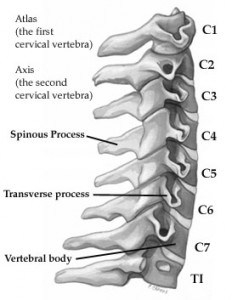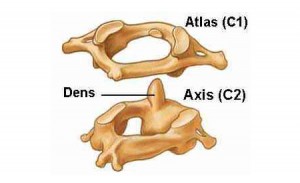 The cervical spine is the top of the vertebral column comprised of seven vertebrae (C1-C7) with the ribcage sitting below and the head resting above.
The cervical spine is the top of the vertebral column comprised of seven vertebrae (C1-C7) with the ribcage sitting below and the head resting above.
The cervical spine curves in just like the lumbar spine. In fact, these two curves of the lower back and the neck are meant to have the exact same degree of curve.
The cervical vertebrae are smaller than those of both the thoracic and lumbar spine.
The cervical spine also has access too much more movement in terms of flexion, extension, and rotation. Another distinction of the cervical spine is that they have holes (foramen) on each side of the vertebrae to allow for arterial blood flow.
The seven vertebrae of the cervical spine provide mobility and stability for the head. A great deal of this mobility comes from the top two vertebrae known as the atlas and the axis.
The atlas and the axis, C1, and C2, are unique bearing little resemblance to the rest of the vertebrae of the spinal column.
The atlas and the axis are designed for maximizing movement.
The atlas (C1) has no vertebral body; it is essentially a ring that sits on top of the axis. The axis (C2) is the pivot around which the head turns.
The odontoid process, or dens, rises up from the back of the axis and allows the atlas to move and rotate around it.
The atlas, named for the Greek titan who held the world upon his shoulders, generally weighs less than a quarter of a pound and holds our eight to ten-pound head on top of it. Our ability to hold our heads up successfully is determined in large part by the delicate balance of the lumber and cervical curves.
 Though the whole of the cervical spine is quite mobile a great deal of the movement originates in the atlas and axis.
Though the whole of the cervical spine is quite mobile a great deal of the movement originates in the atlas and axis.
Half of the rotation in the cervical spine comes from the meeting place of C1 and C2 known as the atlantooccipital joint. Half of the flexion and extension come from the atlanto-occiptial joint where the upper spine meets the head.
Finally, there is a neurological piece to the cervical spine, specifically the atlas and axis. The brain stem extends down through the atlas to the level of the axis, and that will get a post of its own later in the week.
***

